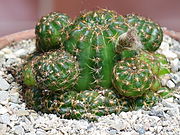
Acanthocalycium is a genus of cactus consisting of several species from Argentina, Bolivia, Brazil, Paraguay and Uruguay. The taxon name comes from Greek akantha and kalyx, which refers to the spines on the floral tubes.

Echinopsis is a genus of cacti native to South America, sometimes known as hedgehog cactus, sea-urchin cactus or Easter lily cactus. As of October 2023, there are about 20 accepted species, ranging from large and treelike types to small globose cacti. The name derives from echinos hedgehog or sea urchin, and opsis appearance, a reference to these plants' dense coverings of spines.

Cleistocactus is a genus of flowering plants in the cactus family Cactaceae, native to mountainous areas - to 3,000 m (9,843 ft) - of South America. The name comes from the Greek kleistos meaning closed because the flowers hardly open.

Pereskia is a small genus of about four species of cacti that do not look much like other types of cacti, having substantial leaves and non-succulent stems. The genus is named after Nicolas-Claude Fabri de Peiresc, a 16th-century French botanist. The genus was more widely circumscribed until molecular phylogenetic studies showed that it was paraphyletic. The majority of species have since been transferred to Leuenbergeria and Rhodocactus. Although Pereskia does not resemble other cacti in its overall morphology, close examination shows spines developing from areoles, and the distinctive floral cup of the cactus family.

Samaipaticereus is a monotypic genus of cactus containing the sole species Samaipaticereus corroanus. It is known only from East Andean Bolivia and Peru.

Yungasocereus is a monotypic genus of cacti. Its sole species is Yungasocereus inquisivensis, native to Bolivia.
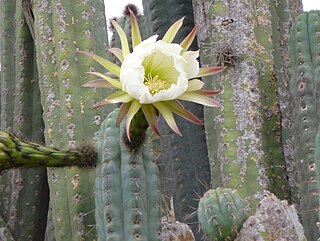
Echinopsis lageniformis, synonyms including Echinopsis scopulicola and Trichocereus bridgesii, is a cactus native to Bolivia. It is known as the Bolivian torch cactus. Among the indigenous populations of Bolivia, it is sometimes called achuma or wachuma, although these names are also applied to related species such as Trichocereus macrogonus which are also used for their psychedelic effects.
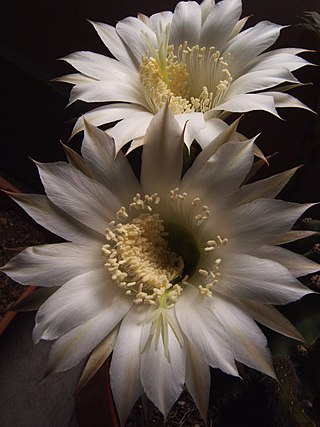
Echinopsis oxygona also known as Eyries cactus, Easter lily cactus or sea-urchin cactus is a species of flowering plant in the cactus family Cactaceae, native to South Brazil, Uruguay and northern Argentina. Its features include many robust spines, spherical shape, and a large flower, with sharply pointed lavender or white petals, and a fine faint scent.

Trichocereus macrogonus, synonym Echinopsis macrogonus, is a species of cactus found in Ecuador, Peru and Bolivia. Two varieties are accepted as of September 2023: var. macrogonus and var. pachanoi. Plants contain varying amounts of the psychoactive alkaloid mescaline. They have been used both ritually and in traditional medicine from pre-Columbian times. Trichocereus macrogonus is one of a number of similar species that may be called San Pedro cactus. Indigenous names include achuma and huachuma, although these too may be applied to similar species.

Chamaecereus silvestrii is a species of cactus from northwestern Argentina and Bolivia. Synonyms include Echinopsis chamaecereus and Lobivia silvestrii. It has been called the peanut cactus. This plant should not be confused with Echinopsis silvestrii, a synonym of Echinopsis albispinosa, a species with a very different appearance.

Lobivia mamillosa is a species of cactus from Bolivia.

Rebutia minuscula is a species of cactus from South America found in northern Argentina and Bolivia. It is the type species of the genus Rebutia. As its synonym Rebutia senilis it has gained the Royal Horticultural Society’s Award of Garden Merit. Its cultivars 'Krainziana', 'Marsoneri' and 'Violaciflora' are also listed as having gained the Award of Garden Merit.
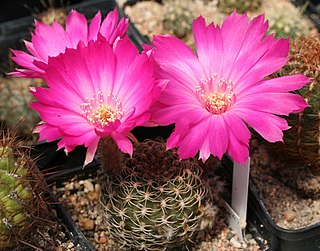
Lobivia backebergii is a species of flowering plant in the cactus family Cactaceae, native to eastern Bolivia and southern Peru.

Cleistocactus samaipatanus is a species of flowering plant in the family Cactaceae, native to Bolivia.

Lobivia cinnabarina is a species of cactus first described in 1885.

Lobivia ancistrophora is a species of cactus. It has a globular shape, few spines, with large, white flowers attached to long, green tubes. It occurs in Bolivia, at altitudes of 600–1800 metres. Under its synonym Echinopsis ancistrophora it has gained the Royal Horticultural Society's Award of Garden Merit.
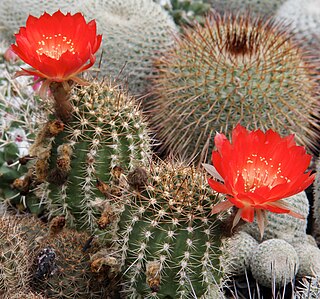
Lobivia hertrichiana is a species of Lobivia found in Bolivia and Peru.

Lobivia pentlandii, is a species of Lobivia found in Bolivia and Peru.

Aylostera pulvinosa, synonym Rebutia pulvinosa, is a species of cactus in the genus Aylostera, native to Bolivia. Aylostera albiflora has been treated as Aylostera pulvinosa subsp. albiflora.
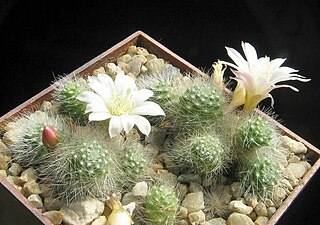
Aylostera albiflora, synonym Rebutia albiflora, is a species of flowering plant in the family Cactaceae, native to Bolivia. It was first described by Curt Backeberg in 1963 as Rebutia albiflora.

